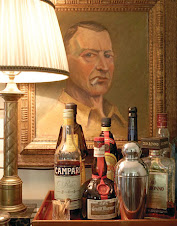
Oh My Gosh. Can you imagine giving this to a beloved young one, or an old ogre like me. I'll Let you know how much love this will cost.
The entire collection went for 1,262,863 GBP. If you'd like to see what individual prints and books fetched click here.
From the Economist:
That sort of bear
Dec 13th 2008
From Economist.com
A fine collection of British storybook treasures up for sale
CHRISTMAS is the season of great gifts for little people. Last year J.K. Rowling, the creator of Harry Potter, raised £1.96m ($2.9m) for a children’s charity when she auctioned off a single copy of her hand-written, silver-bound limited edition “Tales of Beedle the Bard”. This year it is the turn of another fairytale character, Winnie-the-Pooh.
A.A. Milne and his illustrator, E.H. Shepard, were the J.K. Rowlings of their time. Between 1926 and 1928, the three small books they published about the fat little bear introduced not just a fresh cast of characters, but a whole new world still beloved by children today.
The books were inspired by stories Milne liked to tell his young son, Christopher Robin. The hero was the bear of very little brain, Winnie-the-Pooh, who liked to play with his friends—Roo, Piglet, Owl, Eeyore and others—in the Hundred Acre Wood (or the “100 Aker Wood”, as it was often written).
Sotheby's
Sotheby's
Winnie-the-Pooh lived in the forest all by himself under the name of Sanders. He liked to make up hums and was always ready for a “Smackeral of Something”. Being “that sort of bear”—greedy, cack-handed and a little bit dim—he became the hero of a series of small but meaningful dramas that inevitably concerned food, weather, accidents or misunderstandings, such as the donkey Eeyore’s tail being appropriated by Owl as a bellpull.
The collaboration between author and illustrator got off to a shaky start when Milne reacted badly to the publisher’s suggestion that Shepard take on the drawings. Milne had seen the artist’s cartoons in Punch magazine and thought him “hopeless”. But Shepard’s lightly caricatured style, like that of Jean de Brunhoff, creator of Babar the elephant, would prove adept at giving visual shape to Milne’s comic verses. The author was quickly converted, and in a presentation copy of the first American edition of “Winnie-the-Pooh” that was signed by both men, Milne penned a verse in tribute to his collaborator.
When I am gone,
Let Shepard decorate my tomb,
And put (if there is room)
Two pictures on the stone:
Piglet, from page a hundred and eleven,
And Pooh and Piglet walking (157)…
And Peter, thinking that they are my own,
Will welcome me to Heaven.
Sotheby's
Sotheby's
Stanley Seeger, the heir to an American lumber fortune who has lived in London for most of his adult life, and his partner, Christopher Cone, have spent nearly three decades buying Pooh-fernalia. Their collection, probably the finest in private hands, includes numerous first editions, preparatory sketches and other works illustrated by Shepard, including his other great children’s work, “The Wind in the Willows”. But it is the iconic Pooh drawings that are likely to create the most interest when they come up for sale later this month.
Among them is the first depiction of Pooh bear (Lot 6), his cosy idleness and dim-wittedness instantly apparent. He is sitting on a log before a fire; behind him hangs a doorbell with a sign under it—RNIG ALSO. Two illustrations from the chapter in which Pooh goes visiting (Lot 8, pictured at left) are all that are needed to understand his greedy nature. He pushes his way through a hole into the lair where his friend Rabbit lives. But having feasted on honey and condensed milk, Winnie-the-Pooh gets stuck on his way out. “Oh, help!” said Pooh. “I’d better go back”. “Oh, bother!” said Pooh. “I shall have to go on.” “I can’t do either!” said Pooh. “Oh help and bother.”
The chapter where Piglet is surrounded by water, “The Floating Bear”, Winnie-the-Pooh is back at the honey. In a remarkable series of six small drawings, he rolls over and over trying to get on top of the honey jar: “If a bottle can float, then a jar can float, and if a jar floats, I can sit on top of it, if it’s a very big jar.” The complete sequence of six drawings (Lot 17) is one of the rarest items in the sale, as is the last drawing in the book (Lot 19). Christopher Robin has given his Pooh party. The little boy carries off his toy bear by the foot, “bump, bump, bump…up the stairs behind him” (pictured at top). It is time to say goodnight.
E.H. Shepard’s Winnie-the-Pooh from the collections of Stanley J. Seeger and Christopher Cone will be sold at Sotheby’s in London on December 17th
Adaptive reuse: Chateau of the Hertford British Hospital
-
Buildings with specific uses often find themselves out of a job so to
speak. Rather than tear down (often wonderful) old buildings, rehabbing
them is the...
6 months ago

















2 comments:
I have loved Pooh since I was small. I always will. I would buy all of this if only there were enough money....
ML
mlanesepic.blogspot.com
If only...
"Bump, bump, bump. Down the funny stairs..."
Being a Christopher, I was introduced to "Now We Are Six" ("They're changing guards at Buckingham Palace/Christopher Robin went down with Alice...") early on and Pooh followed fast on it's heels. Wonderful stuff! Disney never quite captured the whimsy of the original drawings.
Post a Comment